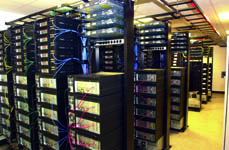|

Supercomputers
at the Natural History Museum
by
Sarah Elzas
In
natural history museums, dinosaurs are usually displayed as skeletons,
not as code scrolling down computer screens. Yet, this is just
how a dozen students from various schools saw them after they
created a ‘supercomputer’ as part of the American Museum of Natural
History’s first conference examining the growing prominence of
parallel—or cluster—supercomputers. The students, participating
in the Museum’s Pre-College Science Collaborative, assembled 16
hard-drives into an eight-unit supercomputer to run a program
called POI that would compute the relationship between dinosaurs
and modern birds.
“It’s
amazing how fast they can go,” said Jacqueline Kahan, a seventh
grader at the Beacon School referring to the supercomputer. While
a home computer can compute 256 million calculations per second,
a cluster computer can compute 80 billion. “That’s a pretty amazing
amount of math,” said Jeff Oishi, the show presenter for the planetarium,
who was working with the students.
What’s even more amazing is that the computer is made up of desktop
PC parts. “Using simple tools, we can solve problems that would
otherwise be impossible,” said Oishi. Parallel computers distribute
parts of large problems over individual hard-drives and then combine
the results into a final answer. This is much faster than solving
the problem using just one hard-drive working in a linear fashion.
“This
is a different kind of computing than many of us are used to,”
explained Oishi. “It’s not terribly exciting to watch happen,
but to know that it’s actually doing science inside is quite exciting.”
While speeding up science, parallel computing also reduces costs.
The computer Oishi works with at the museum, that is made up of
280 smaller computers, costs less than $1 million to build, significantly
less than “old school” supercomputers that could run up to $15
million.
The students were all impressed with the cluster’s speed, although
it didn’t surprise Sheldon Nathaniel, a senior at Van Dorf high
school, who has worked with the Museum’s supercomputer before.
He wrote a program to look at how molecular clouds come together
using gravity.
Biologists and physicists use supercomputers in different ways.
Biologists will take the data they have collected and will write
programs to find connections between them. Physicists start with
laws of physics and project what might happen. “If we can stipulate
the life of a star, then we can speed up time in the computer,”
explained Oishi. In this way, a human can see the whole lifespan
of a star that would otherwise take millions of years.
The POI program finished after 21 minutes. It had created a cladogram,
a map in which each dinosaur—caudipteryx zoui, Byronosaurus jaffei,
Rahonavis ostromi—had been inserted. The beauty of the computer
is that “just having one or two fossils can help predict others
that have not been found yet,” explained Mark Norell, the Chair
of the Division of Paleontology, who helped to analyze the results.
And ultimately, that is what science is all about. #
Education Update, Inc., P.O. Box 20005, New York, NY 10001. Tel:
(212) 481-5519. Fax: (212) 481-3919. Email: ednews1@aol.com.
All material is copyrighted and may not be printed without express consent of
the publisher. © 2001.
|

